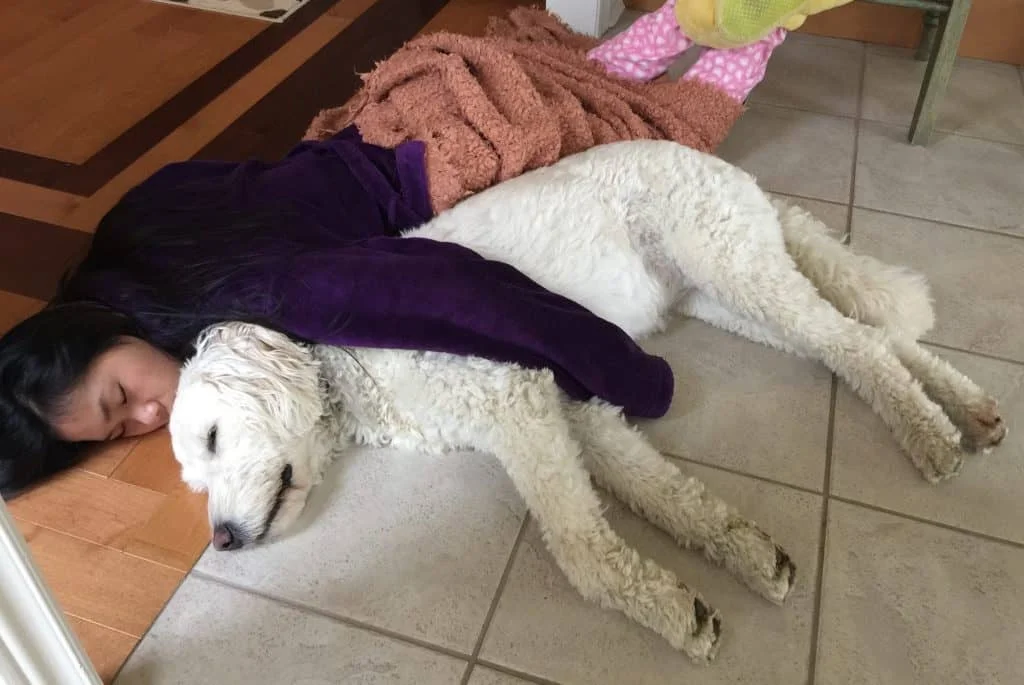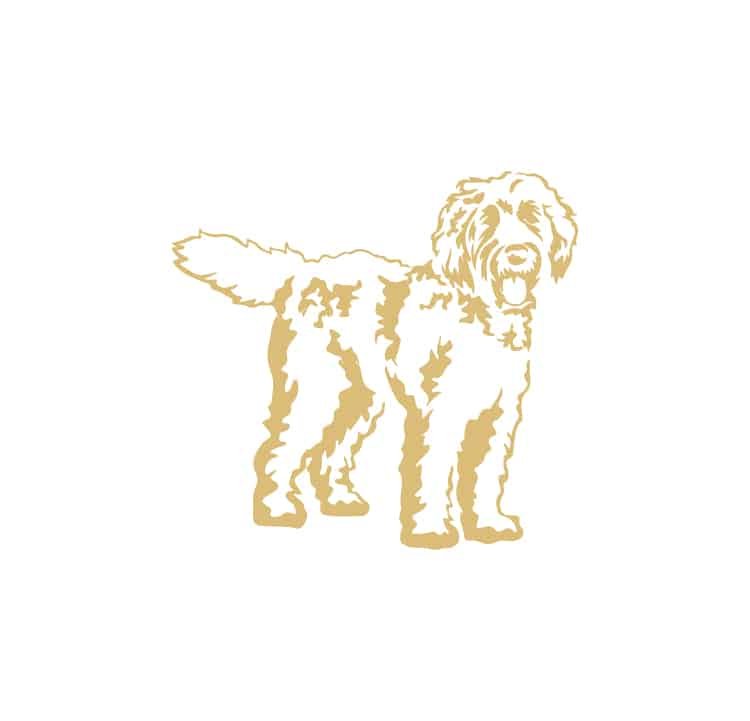Are Labradoodles Good For Families With Allergies?
Labradoodles are hypoallergenic. That being said, given the unpredictable nature of crossbreeding, you would do well to keep an open mind. What goes in favor of the labradoodle is that it inherits its coat from the Poodle. They are not much of a shedder. But because Labrador retrievers shed a lot, an odd doodle could turn out not to be allergy-friendly,
On average, Labradoodles shed once in 3-4 weeks. This is a significant improvement on many dog breeds, which are prolific shedders, and tend to create a permanent pet-hair and dander atmosphere.
The lesser the dog sheds, the better it is for pet owners regarding allergy issues and cleaning. However, whether or not the doodle is hypoallergenic depends on factors such as type, generation, and overall health and wellness.
What Does ‘Hypoallergenic’ Imply?
Before ascertaining whether your doodle can cause allergy, it is time to take a step back and understand dog allergies. Anything unlikely to trigger an allergy is referred to as being ‘hypoallergenic.’ The term is broadly applied to various niches ranging from garments and cosmetics to pets, depending on their reaction.
‘Hypoallergenic’ is also referred to as allergy-friendly, meaning the product in question is suitable for people that suffer from allergic reactions.
When it comes to pets, most people blame the hair/fur for all the allergic symptoms. But, contrary to the popular opinion, it is the saliva and urine which is responsible.
These contain a protein that sticks to the pet’s skin’s dead cells and causes it to become flaky. Commonly known as dander, it is these flakes that trigger allergic symptoms.

Are you Allergic to Labradoodles?
Someone who is allergic to pets may or may not be able to stand a labradoodle’s presence. Regardless of the doodle being hypoallergenic, your physiology comes into play in determining if you can stand the company of a pet.
If you are just mildly allergic, Labradoodles are the perfect option. In this mildest form, allergy is triggered only by pet-fur or a bit of dander, both of which are not a problem as far as doodles are concerned
But if your allergy is being triggered by the urine/saliva of the pet, then the situation might be a lot trickier. Despite the doodle being allergy friendly, its presence might still cause you a lot of discomforts.
Under the circumstances, the best option is to consult a doctor and determine your allergy type before bringing home a doodle. While Labradoodles are safe for most people, you would do well first to spend an experimental 24 hours with one to check if there is a reaction.
Depending on the outcome, you can make an informed decision as to whether or not it would be feasible to enjoy the companionship that comes as part of the furry bundle.
How to Choose a Labradoodle
While choosing a labradoodle for your home, there are two main aspects that you need to look out for that could make a lot of difference to the allergy –
- Type of coat the doodle sports
- Types of Labradoodles
Type of Coat
Courtesy of their mixed parentage, Labradoodles can sport three different kinds of coats, the options being –
- Wooly, which is a hallmark of a Poodle, is allergy-friendly and requires regular brushing and grooming;
- Fleece, which is the easiest to maintain, does not shed and is the best option for allergy/asthma patients;
- Hair, which could be straight, curly, or wavy, is prone to shedding and can trigger a reaction in people with low tolerance;
Types of Labradoodles
What type the doodle can also impact its hypoallergenic nature. Doodles can be an outcome of –
Labrador retriever with Poodle – F1
A labradoodle born by mating a Labrador retriever and a Poodle can either have a fleece coat or a wiry coat. Their genetic makeup comprises equal parts of each of the parent breeds, so the pup could as equally take off after its Labrador retriever parent as it can after its Poodle parent.
Due to the difference in coat quality and type, the grooming requirements also vary, as does the shedding. Neither coat is allergy-friendly, so this type of doodle is not recommended to anyone who is even slightly sensitive.
First-Generation Labradoodle with Poodle – F1B
These are second-generation doodles and are more allergy-friendly due to having inherited most of their genetic makeup from the Poodle. Someone who suffers from severe symptoms and yet would like to keep a dog must go for this option.
A word of caution here emphasizes that this generation has often exhibited a deviation from the norm, which is why there is always a 50% chance that they might spark an allergy.
Second-Generation Labradoodle with Second-Generation Poodle – F2
Pups born out of both labradoodle parents are the best bet for someone who is allergic or asthmatic. Among Labradoodles, as the generations progress, the tendency to shed declines.
Going by this logic, a natural implication is that these pups will hardly shed, and hence are perfect for allergy and asthma doodle lovers.
But, to be sure, you must check on the labradoodle parents before taking the plunge and keenly observe their coats and saliva.

Tips to Bear in Mind
By bearing the following information in mind, you can improve the chances of getting a hypoallergenic labradoodle –
- Having identified a reputed breeder, make it a point to check the adult Labradoodles and also spend time with them if possible;
- Conduct thorough research on doodle coats and, if potential, quiz a breeder about the characteristics of each coat type to determine which one would work for you best;
- Handle the doodle as you would at home, meaning hug it, bring it close to your face and brush it, to determine if you are allergic and to what extent;
- Rub your clothes or towel on the doodle and bring it back home to check if it triggers a delayed reaction;
- Be aware of your tolerance levels before you get the doodle home, so as not to aggravate the situation;
Labradoodles and Shedding
In the case of dog breeds, shedding is a characteristic of the type of coat. Labrador retrievers shed a lot owing to their double coat. Poodles, on the other side, hardly ever shed. As crossbreeds, Labradoodles have taken off after their Poodle parent and shed minimally as a rule.
Shedding becomes a problem only when the doodle’s coat deviates from the usual hypoallergenic variety. In the event, shedding might be a little more than what is typical for Labradoodles and can trigger a reaction in people with low tolerance levels.
Controlling Pet Allergy
Assuming that your allergic reaction manifests after you have brought home the labradoodle, it is possible to get things under control.
The Following are some measures that could enable you to enjoy the goodness of having a doodle around while keeping your symptoms to the minimum –
- Improve the quality of indoor air by investing in a high-efficiency vacuum cleaner that will remove up to 99% of the particles and make a drastic difference to the air that you breathe;
- Keeping the doodle out of your bedroom can go a long way in alleviating your suffering in the long run;
- Brush your doodle regularly and clear the area immediately after so that the tufts do not spread to other corners of the house;
- Clean the doodle’s bedding every day and wash it with a good quality soap to protect the doodle’s sensitive skin;
- Ensure your doodle’s good health through an enriched diet, fatty acids, and various other essential supplements;
- Use a natural anti-allergen spray on the carpet, curtains, and upholstery to reduce the impact of dander and pet fur;
- Wash your hands thoroughly after having snuggled/touched/hugged the doodle;
- Always keep an anti-allergen tablet close at hand which you can take at the slightest hint of discomfort or a sudden flare-up;
Final Thoughts
As a crossbreed that was created to enable allergic dog lovers to enjoy a pet’s company, the labradoodle scores high on the hypoallergenic chart.
They are a mixed bag of genes wherein the allergy-causing protein present in the saliva and urine of doodles is absent. Add to this that they don’t shed fur or dander as much as other breeds do.
